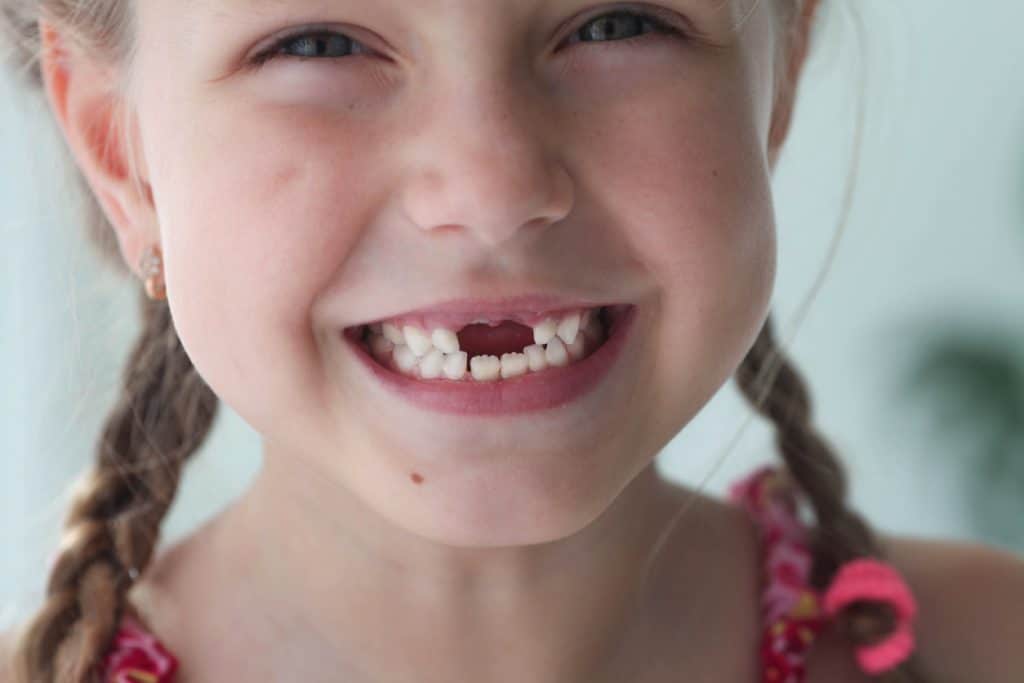Many parents worry about their child's baby teeth falling out. This is a natural process during which the child's 20 temporary teeth give way to permanent teeth.
Find out everything you need to know about the teething cycle and how to manage a baby tooth that falls out.
The composition of the dentition in children
A child's dentition is made up of 20 baby teeth, unlike the adult dentition, which consists of 32 permanent teeth. The first teeth often appear around six months. By the age of three, all 20 baby teeth are in place in the child's mouth.
These 20 temporary teeth usually erupt in the following order:
- The four central incisors,
- The four lateral incisors,
- The first four molars,
- The four canines,
- The four second molars.
The eruption of baby teeth does not occur at the same time and in the same order in all children. It is very common to see eruption before or after six months.
When and how many baby teeth fall out?
The loss of baby teeth is a process that usually takes 6 years from start to finish. The baby teeth begin to move and fall out on their own to make room for the permanent teeth around the age of 6. Of course, not all teeth fall out at the same time.
Some children start losing their baby teeth earlier at age 4, or later at age 7. In general, baby teeth fall out in the order in which they appear.
Between 6 and 7 years: central incisors
Because they are the first teeth to erupt, the central incisors are the first baby teeth to fall out around age 6 or 7.
First, the lower central incisors fall out to make room for the permanent teeth. Then, the upper central incisors fall out in turn.
Between 7 and 9 years old: the lateral incisors
After the loss of the four central incisors, it is the turn of the lateral incisors to give way to the permanent teeth. The upper lateral incisors often fall out first around the age of 7 or 9.
Between 9 and 11 years old: the first molars and canines
The first molars and canines usually fall out between the ages of 9 and 11. First the lower and then the upper canines fall out. Then, the first lower and upper molars.
Between 11 and 13 years old: second molars
The last baby teeth to fall out are the four second molars. These last teeth are usually lost between the ages of 11 and 13.
The child's jaws also develop throughout the process of losing baby teeth. By age 13, the child should have lost all 20 baby teeth and have a jaw that is capable of receiving permanent teeth.
Falling baby teeth: the right reflexes to have
Tooth loss is a time that is perceived differently from one child to another. Some find it exciting, while others may be upset. The loss of a tooth may seem permanent to a child.
It is recommended to make the falling out of a baby tooth funny by using, for example, the visit of the tooth fairy during the night. It is also important to explain to the child that this is a natural occurrence and that a new tooth will grow in its place.
The loss of a baby tooth is usually painless. However, it is common for the bleeding to cause discomfort to the child. Rinsing the mouth with water and possibly applying a clean, damp cloth to the wound is enough to stop the bleeding.
Moving baby tooth: how long does it take to fall out?
It is best to let the tooth fall out on its own to avoid causing any pain. When they feel a tooth moving, children often start to move it with their fingers or tongue. The tooth should fall out naturally in a short time.
If a tooth moves but refuses to fall out, it is customary to have the child bite into a green apple to get the tooth to dislodge.
If the tooth still refuses to fall out, take the child to the dentist to find out if there is a problem.
When to go to the dentist?
It is recommended to go to the dentist with a child from the age of two or three. This allows the child to get used to the practice and to future check-ups.
At the same time, parents are reassured that they don't have to worry about their child's oral health. The dentist checks that no teeth are infected with cavities and that the baby teeth and jaws are developing well.
It is quite common for the permanent tooth to start appearing while the baby tooth has not yet fallen out. This problem is often temporary. If it persists, it is necessary to go to the dentist to analyze the situation.
The time it takes for baby teeth to fall out varies greatly from child to child. You should not be overly concerned if a child's teeth take longer to fall out. If your child is unsure, uncomfortable or in pain, see a dentist for advice.


